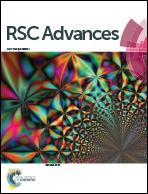Design and synthesis of hyperbranched polyimide containing multi-triphenylamine moieties for memory devices†
Abstract
A novel triamine monomer, N,N′,N′′-tris(4-methoxyphenyl)-N,N′,N′′-tris(4-phenylamino)-1,3,5-benzenetriamine, was designed and synthesized. A hyperbranched polyimide (HBPI) was prepared by reacting the triamine monomer with 4,4-(hexafluoroisopropylidene)diphthalic anhydride for application in memory devices. The resulting HBPI exhibited excellent organo-solubility and high thermal stability. A memory device with a sandwich structure of indium tin oxide (ITO)/HBPI/Al was fabricated by using HBPI as an active layer. The device exhibited static random access memory (SRAM) behavior with a relatively low switching voltage of −1.90 V. Moreover, the device showed good stability in both the OFF and ON states, which could be retained as long as 1 × 104 s under a constant voltage stress of −1.00 V with an ON/OFF current ratio reaching up to 1 × 106. Molecular simulation results suggested that efficient charge transfer between the triamine moieties and hexafluoropropylidene phthalimides moieties in HBPI exist, which is responsible for the improved electrical memory performance. Such a HBPI was expected to be potentially useful in polymer memory applications.


 Please wait while we load your content...
Please wait while we load your content...